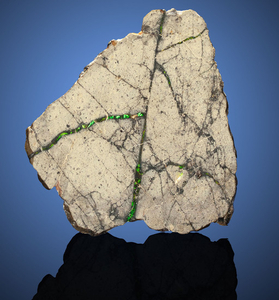NWA 10178 — A SLICE OF A LUNAR METEORITE, Lunar troctolitic granulite Sahara Desert
This is a slice of a Moon rock. The cut face reveals a central vein of shock melt from which filigree shock melt radiates from both sides through a fine-grained matrix with glittering maskelynite — an impact glass. A desert varnish, the result of being naturally sandblasted by desert winds for generations, provides a waxy finish on the meteorite’s exterior rim. When backlit, the green emerald-hued glass in this meteorite is readily apparent. The Moon is among the rarest substances on Earth, and precious little contains veins of translucent green glass. Modern cutting,
67 x 63 x 2 mm. (2.66 x 2.5 x 0.1 in.)
12.9 g.
The Moon is among the rarest substances on Earth, and now offered is a piece of the Moon ejected from the lunar surface as a result of an asteroid impact. There are less than 600 kg of lunar meteorites known to exist and a significant fraction is controlled by governmental institutions. While Apollo astronauts returned with close to 400 kg of Moon rocks, not one milligram is available for private ownership. Every lunar meteorite known would fit in four footlockers. Moon rocks are identified by specific textural, mineralogical, chemical and isotopic signatures. Many of the common minerals found on Earth’s surface are rare or absent on the Moon and some lunar minerals are unknown on Earth. In addition, Moon rocks contain gases captured from the solar wind with isotope ratios very different from the same gases found on Earth. As one would expect, many of the Apollo samples returned to Earth are nearly identical to lunar meteorites. As for the specimen now offered, it was recovered by Berber nomads in 2015 from an undisclosed location in the Sahara Desert. Unlike most lunar meteorites which are breccias (regolithic or feldspathic), NWA 10178 is a troctolitic granulite, a fine-grained breccia composed of abundant anorthite (converted to maskelynite), olivine, orthopyroxene and pigeonite and small amounts of chromite and troilite. Maskelynite is a shock-produced glass that forms following an impact, probably the impact that launched it off the lunar surface. This meteorite was classified by Dr. Anthony Irving, among the world’s foremost classifiers of planetary material.
The mass from which this slice was cut will be on display at the Maine Mineral & Gem Museum.
Christie's would like to thank Dr. Alan E. Rubin at the Institute of Geophysics and Planetary Physics, University of California, Los Angeles for his assistance in preparing this catalogue note.
View it on
Sale price
Estimate
Time, Location
Auction House
This is a slice of a Moon rock. The cut face reveals a central vein of shock melt from which filigree shock melt radiates from both sides through a fine-grained matrix with glittering maskelynite — an impact glass. A desert varnish, the result of being naturally sandblasted by desert winds for generations, provides a waxy finish on the meteorite’s exterior rim. When backlit, the green emerald-hued glass in this meteorite is readily apparent. The Moon is among the rarest substances on Earth, and precious little contains veins of translucent green glass. Modern cutting,
67 x 63 x 2 mm. (2.66 x 2.5 x 0.1 in.)
12.9 g.
The Moon is among the rarest substances on Earth, and now offered is a piece of the Moon ejected from the lunar surface as a result of an asteroid impact. There are less than 600 kg of lunar meteorites known to exist and a significant fraction is controlled by governmental institutions. While Apollo astronauts returned with close to 400 kg of Moon rocks, not one milligram is available for private ownership. Every lunar meteorite known would fit in four footlockers. Moon rocks are identified by specific textural, mineralogical, chemical and isotopic signatures. Many of the common minerals found on Earth’s surface are rare or absent on the Moon and some lunar minerals are unknown on Earth. In addition, Moon rocks contain gases captured from the solar wind with isotope ratios very different from the same gases found on Earth. As one would expect, many of the Apollo samples returned to Earth are nearly identical to lunar meteorites. As for the specimen now offered, it was recovered by Berber nomads in 2015 from an undisclosed location in the Sahara Desert. Unlike most lunar meteorites which are breccias (regolithic or feldspathic), NWA 10178 is a troctolitic granulite, a fine-grained breccia composed of abundant anorthite (converted to maskelynite), olivine, orthopyroxene and pigeonite and small amounts of chromite and troilite. Maskelynite is a shock-produced glass that forms following an impact, probably the impact that launched it off the lunar surface. This meteorite was classified by Dr. Anthony Irving, among the world’s foremost classifiers of planetary material.
The mass from which this slice was cut will be on display at the Maine Mineral & Gem Museum.
Christie's would like to thank Dr. Alan E. Rubin at the Institute of Geophysics and Planetary Physics, University of California, Los Angeles for his assistance in preparing this catalogue note.



